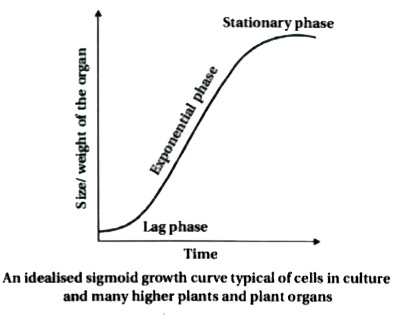Describe briefly :
(a) Arithmetic growth
(b) Geometric growth
(c) Sigmoid growth curve
(d) Absolute and relative growth rates
Text Solution
(a) Arithmetic growth : In arithmetic growth, following mitotic cell division, only one daughter cell continues to divide while the other differentiates and matures.
The simplest expression of arithmetic growth is exemplified by a root elongating at a constant rate.
(b) Geometric growth : Geometric growth is characterised by a slow growth in the initial stages and a rapid growth during the later stages. The daughter cells derived from mitosis retain the ability to divide but slow down because of a limited nutrient supply.
(c) Sigmoid growth curve : The growth of living organisms in their natural environment is characterised by an .S. shaped curve called sigmoid growth curve. This curve is divided into three phases lag phase, log phase or exponential phase of rapid growth and stationary phase.
Exponential growth can be expressed as W1=W0ert
Where W1= Final size
W0= Initial size
r = Growth rate
t = Time of growth
e = Base of natural logarithms

An idealised sigmoid growth curve typical of cells in culture and many higher plants and plant organs
(d) Absolute and relative growth rates : Absolute growth rate refers to the measurement and comparison of total growth per unit time.
Relative growth rate refers to a particular system per unit time, expressed on a common basis.
|
Topper's Solved these Questions
- PLANT GROWTH AND DEVELOPMENTBook:KUMAR PRAKASHANChapter:PLANT GROWTH AND DEVELOPMENTExercise:SECTION - E (SOLUTION OF NCERTY EXEMPLAR)(MULTIPLE CHOICE QUESTIONS : (MCQs))
Explore 12 Videos
- PLANT GROWTH AND DEVELOPMENTBook:KUMAR PRAKASHANChapter:PLANT GROWTH AND DEVELOPMENTExercise:SECTION - E (SOLUTION OF NCERTY EXEMPLAR)(VERY SHORT ANSWER TYPE QUESTIONS : (VSQs))
Explore 16 Videos
- PLANT GROWTH AND DEVELOPMENTBook:KUMAR PRAKASHANChapter:PLANT GROWTH AND DEVELOPMENTExercise:SECTION - C (DEFINITION/EXPLANATION - TERMS/IMPORTANCE)
Explore 18 Videos
- PHOTOSYNTHESIS IN HIGHER PLANTSBook:KUMAR PRAKASHANChapter:PHOTOSYNTHESIS IN HIGHER PLANTSExercise:FILL IN BLANKS
Explore 10 Videos
- PLANT KINGDOMBook:KUMAR PRAKASHANChapter:PLANT KINGDOMExercise:OBJECTIVE SECTION (FILL IN THE BLANKS)
Explore 9 Videos
Similar Questions
Knowledge Check
The absolute growth rate is
Ameasurement and the comparison of total growth rate per unit time.Bgrowth rate in whole life .Cgrowth from birth to deathDper unit initial parametersA sigmoid growth curve is characteristic of -
ABacteria growing in culture mediumBOrganisms growing in natural habitatCAll cells, tissue and organsDAllPopulation growth curve is sigmoid, if the growth pattern is
ALogisticBGeometricCExponentialDAccretionary
The absolute growth rate is
View SolutionPlant growth and development ||Plant Growth || Phases OF Growth || Growth Rate || Arithmetic Growth || Geometric Growth || Growth Curve || Absolute Growth and Relative Growth
View SolutionWhat does the sigmoid growth curve of a population mean ?
View SolutionPopulation growth-curve is sigmoid, if the growth pattern is
View SolutionSigmoid/logistic growth curve is represented by
View Solution

